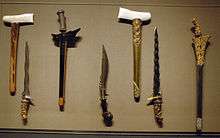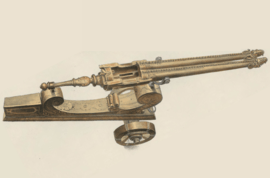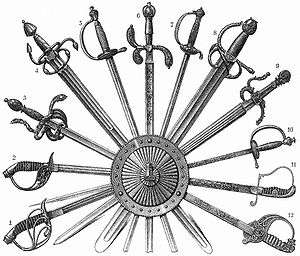Mandau (knife)
Mandau[1] is the traditional weapon of the Dayak people of Borneo.[2][3] It is also known as Parang Ilang among the Bidayuh, Iban and Penan people, Malat by the Kayan people or Baieng by the Kenyah people or Bandau by Lun Bawang or Pelepet/Felepet by Lundayeh. Mandau is mostly ceremonial. However, a less elaborate version called Ambang is used as an everyday practical tool.
| Mandau | |
|---|---|
 A Mandau complete with a Langgei Puai (whittling knife), pre-1927. | |
| Type | Sword, Cutlass, Ceremonial Knife |
| Place of origin | Borneo (Brunei, Indonesia, Malaysia) |
| Service history | |
| Used by | Dayak (Sea Dayak, Bidayuh, Kayan, Kenyah, Penan, Lun Bawang/Lundayeh) |
| Specifications | |
| Blade type | Single edge, one side convex and concave on the other side |
| Hilt type | Antler/deer horn, wood, animal or human hair |
| Scabbard/sheath | Wood, antler or bone fittings, animal or human hair |
Associated with the Headhunting Ceremony, where people would gather to attack other tribes, and gather heads to be used in various festivities, Mandau is both a work of art in itself and a weapon.
Description
Characteristics for the Mandau is that the blade is shaped convexly on one side and somewhat concavely on the other side.[4] The blade is mostly made of tempered metals, with exquisite vine-works and inlaid brass. The hilt is made from animal horns, such as deer's horns, although some variations with human bones and fragrant wood also have been found. Both the hilt and scabbard are elaborately carved and plumed. Details of carvings vary from tribe to tribe, but mostly depict creatures or, if human bones were used, anthropomorphic deities. A Mandau is often accompanied with a whittling knife, generally referred to as Pisau raut.
Ambang
Ambang is a term used for Mandau that is made from common steel. Often it is also made as souvenir. For the untrained eye and those who are not familiar with the Mandau, will not be able to distinguish the difference between a Mandau and an Ambang because of the outlook appearance that looks almost similar. However the two are actually very different. If one examines in detail, the differences are very obvious that the engravings can be found on the blade and it is embedded with gold, copper or silver. The Mandau holds a stronger edge and with flexibility, as it is said that the Mandau is made from iron ore obtained from rocky mountains forged by skilled blacksmiths. Whereas the Ambang is made from ordinary steel.[5]
See also
References
- Active Interest Media, Inc. (October 1984). Black Belt. Active Interest Media, Inc. pp. 41–. ISSN 0277-3066.
- Lumholtz, Carl (1920). Through Central Borneo. C. Scribner's sons. ISBN 978-1-314-54676-7.
- unknown (2003). Arts of Asia – Volume 33, Issues 4-6. Arts of Asia Publications, University of Virginia. ISSN 0004-4083.
- Albert G Van Zonneveld (2002). Traditional Weapons of the Indonesian Archipelago. Koninklyk Instituut Voor Taal Land. ISBN 90-5450-004-2.
- Yuyus Kardiman, Yasnita Yasin, Aslidar & Windi Marathun Sholiha (2010). Masyarakat Indonesia: teropong antropologi budaya Indonesia. Laboratorium Sosial Politik Press. ISBN 60-287-6809-X.CS1 maint: multiple names: authors list (link)
External links
| Wikimedia Commons has media related to Mandau. |



